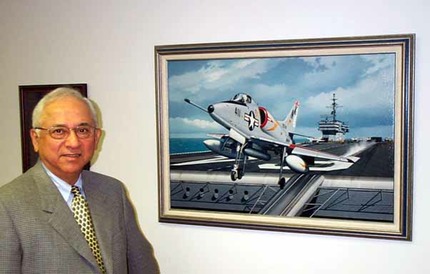It was about 1969 or 70. I was heavily engaged in support of the California High School Coaches Association. We were waging a good fight to maintain P.E. as an essential requirement for K through 12 in California public schools. The state legislature, in all its ignorance, saw health and P.E. as unnecessary.
We were holding our annual state conference at the San Francisco Community College, basically a large indoor convention center. Our keynote speakers were Clint Eastwood and the longest held U.S. captive in Vietnam, Lt. Everett Alvarez, who retired from the Navy as a Commander in 1980.
Alvarez was shot down by the North Vietnamese during an air attack and spent eight and a half years in captivity, mostly in a bamboo cage. He was tortured, starved and beaten regularly. When eventually released, he weighed about 125 pounds.

Retired Navy Cmdr. Everett Alvarez Jr. in a 2004 photograph standing by a painting of the A4C Skyhawk jet fighter he was shot down in over North Vietnam on Aug. 5, 1964. Photo by Rudi Williams.
I was asked to pick up Lt. Alvarez at the San Francisco International airport. Eastwood, basically a jock, heard that Alvarez was arriving and asked if he could come along. To sweeten the request, he offered his personal limo.
So there was Coach Keelor cruising to the airport in the back seat of Clint Eastwood’s limo chatting about Beverly Hills High School football and responding to how anyone could expect a winning football program with such a privileged group of kids. I asked how a guy like him could put up with all the crap in Hollywood. We both agreed it wasn’t easy, but well worth it.
When we got to the airport, Eastwood insisted in going to the gate with me. I didn’t have a clue what Alvarez looked like so I wrote his name on a cardboard lid and held it up as the passengers departed. Alvarez came out and looked like a million bucks. Fit, confident, Hollywood smile—and energy. Meanwhile, autograph seekers were hounding both him and Eastwood.
Alvarez told the coaches in the auditorium that evening that it was the competition, the gamesmanship, the joking around and the serious competition that kept his hope alive
On the way back to the convention center, Alvarez told us why he wanted to speak to the coaches. Growing up in California, Alvarez played football and ran track. He said that when he was being tortured and mutilated, he thought of how tough it was during two-a-day football practices. And he remembered his coaches insisting he could not give up. Apparently, his coach was very inspirational and knew high school football was about lessons in life, not just winning games.
At one point during his incarceration, Alvarez was put in a bamboo cage. He had to lie down to enter and the top closed over him somewhat like a bamboo casket. There were several other POW’s in the same place and same situation. They could hear one other.
Alvarez designed a fitness contest of pull-ups on the bamboo. Since they were lying flat, it was more like a half body pull up. Anyway he began a contest that expanded and carried on for years. Scores were kept, referees, the whole nine yards.
Eastwood listened quietly. He told Alvarez how proud all Americans were of him and thanked him for his service to our country. It was pure appreciation; unrecorded, genuine and from his heart.
At the time, Eastwood was also mayor of Carmel by the Sea, a quaint beachside village just south of San Francisco and only 50 miles or so from the convention center. When we arrived at the hotel, Eastwood offered his hand, thanking me for allowing him to join us in picking up Lt. Alvarez. It “made my day.”
Alvarez told the coaches in the auditorium that evening that it was the competition, the gamesmanship, the joking around and the serious competition that kept his hope alive during that 8½ years of torture and maleficence.
He was a terrific speaker. The California Coaches Association was on its feet about 80% of the time he was at the podium. Most of his remarks were not about winning games but about practice. Heat, sweat, coaches urging players to dig deeper, exhaustion, the pain of hitting, and reaching inside and finding the tank was still not empty. There wasn’t a dry eye in the house.
As he finished and stepped from the podium Alvarez received a "standing O” from the 300-plus members of the California Coaches Assoc. It went on for about five minutes.
A couple of years later, I left high school coaching and joined the professional staff of the President’s Council on Physical Fitness and Sports. As Director of Federal State Relations, I spent a considerable amount of time up on the Hill.
One day, I was walking to a meeting in one of the Senate Office Buildings. The hall was quiet and there was a single gentleman walking the opposite direction. As we came closer I recognized him, Lt. Alvarez. He smiled at me vaguely, and I introduced myself. We began to talk about that night in San Francisco with Clint Eastwood and he gave a gentle laugh, shaking his head in agreement.
He said, “Yes, that was quite an evening. Then, “You know I must have given a couple of hundreds talks over the past several years to high school coaching groups. I don’t think most of them fully understand how powerful their influence can be to impressionable high school age kids. They saved my life.”
Smiling, he shook my hand again and continued on down the hall.
Da Coach
(Look for future inside stories about the fitness and exercise habits of several presidents, law makers, Supreme Court Justice William Rehnquist, Frank Gifford and Howard Cosell, Jack LaLanne, Jesse Owens, Jack Kemp, Jack Russ, Jim Arness, Coach George Allen, and many more.)
